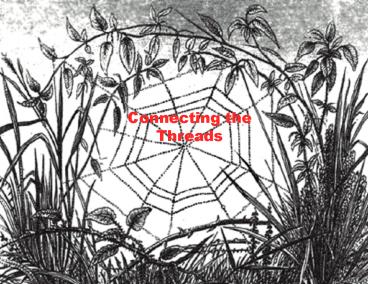Connecting the Threads - PowerPoint PPT Presentation
1 / 12
Title:
Connecting the Threads
Description:
strengthening science education and communication through improved knowledge of the ocean ... with the atmosphere, cryosphere, geosphere, hydrosphere and biosphere. ... – PowerPoint PPT presentation
Number of Views:49
Avg rating:3.0/5.0
Title: Connecting the Threads
1
Connecting the Threads
2
NOPP Structure
U.S. Navy DaRPA NOAA MMS NSF OSTP NASA OMB DoE DoS
EPA USACE USCG USGS
3
Context for IOOS education Planning
4
NOPP Charter
- NOPP established by Congress (Public Law 104-201)
in 1998 - 1. To promote the national goals of
- assuring national security,
- advancing economic development,
- protecting quality of life, and
- strengthening science education and communication
through improved knowledge of the ocean - 2. To coordinate and strengthen oceanographic
efforts in support of those goals bya)
identifying and carrying out partnerships among
federal agencies, academia, industry, and other
members of the oceanographic scientific community
in the areas of data, resources, education, and
communication, and b) reporting annually to
Congress on the Program.
5
NOPP Strategic PlanDraft
- 5 main elements
- IOOSthe observing system
- Education and communications
- Oceanographic infrastructure
- Interagency research and connections to
operations - Interagency and inter-sector partnering
6
ORAP Strategic Education AgendaDraft
- OVERALL GOAL To lead the Nation in articulating,
implementing, coordinating, assessing, and
sustaining a National Agenda that improves public
ocean and coastal literacy and strengthens
science and technology education through an
enhanced understanding of ocean and coastal
concepts and their interrelationship with the
atmosphere, cryosphere, geosphere, hydrosphere
and biosphere. - SPECIFIC GOALS NOPP serves the Nation by
coordinating federal agencies, academia,
industry, and other members of the oceanographic,
scientific and technical communities to - Catalyze, strengthen, and sustain effective
outreach and public education programs - Facilitate the use of the national infrastructure
in advancing the overall goal of improving ocean
literacy and strengthening science and technology
education - Promote the development and diversity of the
ocean-related workforce - Formulate a policy/investment plan designed to
maintain a viable ocean-related education
infrastructure to address ocean and coastal
literacy needs.
7
Build Upon ExistingReports, Plans,
Recommendations
- NSF pre-COSEE workshops and recommendations
- ORION workshop and recommendations
- Agency/program education plans
- NASA, NOAA, USGS, Sea Grant, NMS, etc.
- US Commission on Ocean Policy Report when it is
available (April 20th)
8
Considering Issues think about
- Purpose, policy, program, practice aspects of
Issues - Need for coordination, collaboration, coherency,
continuity and issues these needs might generate - Distributed-local, state, national
- Participation of educators not on the coast?
9
Considering recommendations and strategies
- Build on the best of whats already in place or
underway - Try to avoid reinventing the wheel
- Perfect the wheel for new uses that are
known(wheels evolved from carriages, to
bicycles, to cars, to airplanes, to ..) - Create new where gaps exist
- Use assessment and evaluation to guide decision
making - Again consider
- Purpose, policy, program, practice aspects of
recommendations - Implication for coordination, collaboration,
coherency, continuity within education
10
K-12 Programs
Radio Programs
Internet Programs
Informal Lrn Ctr Exhibits
Park/Sanct/Reserve Programs
Training/ Continuing Ed
Youth Programs
TV Programs
UndergradCurricula
Ocean Science Assets
11
Sample Existing Ocean Education and Science Assets
AMS Edu DataStemes, Maury, Atmo- spheres, etc.
12
K-12 Programs
Radio Programs
Internet Programs
Informal Lrn Ctr Exhibits
Park/Sanct/Reserve Programs
Training/ Continuing Ed
Youth Programs
TV Programs
UndergradCurricula
Ocean Science Assets































